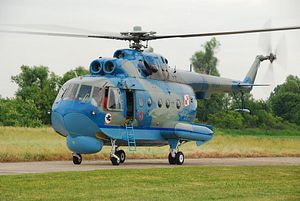Russian Helicopters, Russia’s sole rotorcraft designer, is in the process of evaluating whether to re-start production of the Soviet-era Mil Mi-14 amphibious helicopter, which was formerly equipped with a nuclear bomb capable of destroying any submarine within a 1-kilometer blast area, Flightglobal reported last week.
Russian Helicopters’ predecessor, Mil Moscow Helicopter Plant, designed the aircraft for Soviet Naval Aviation and Soviet allied countries including Cuba, Eastern Germany, Libya and Syria in the late 1960s.
Acccording to Flightglobal, there are currently 44 Mil Mi-14 in active service globally, including in the Syrian Air Force and the Polish Naval Air Arm. The aircraft has been out of production since the 1980s.
Towards the end of the Cold War in the late 1980s, the Mil Mi-14 achieved brief notoriety after it successfully spotted a Western submarine (presumably American) in Soviet territorial waters. Purportedly due to strong pressure from the United States, Russia was forced to scrap its entire Mil Mi-14 fleet in 1996.
“The Mi-14 was so good at submarine hunting that in 1996, under tremendous pressure from Washington, all Russian antisubmarine version Mi-14 helicopters were decommissioned,” RT reported in May 2015.
In reality, however, the Russian Navy was also not capable of maintaining this huge fleet of anti-submarine warfare helicopters after the breakup of the Soviet Union, given the debilitating state of the Russian Armed Forces in the 1990s, with the former Soviet Navy having particular difficulties.
The new Mi-14 helicopter fleet would be produced by Russian Helicopters’ parent company Kazan Helicopter Works (KVZ), located in Russia’s Republic of Tatarstan, which produced 230 Mi-14 aircraft between 1973 and 1986. RT reported that the initial demand by Moscow’s Black Sea and Northern Fleets is estimated at 100 helicopters.
RT summarized the technical specifications of the aircraft back in May:
The Mil Mi-14 is a shore-based amphibious helicopter armed with (optionally) a torpedo, twelve 64kg or eight 120kg depth bombs. This submarine killer also had very special ammo in its arsenal: a 1 kiloton nuclear antisubmarine bomb weighting 1,600kg, capable of scuttling any underwater target within a radius of 800 meters.
The chopper not only had a unique capability of landing on water, but was an all-weather long-range helicopter capable of operating as far as 300km offshore.
The helicopter could stay airborne for 5.5 hours and cover a total distance of 1,100km.
Additionally, defenseworld.net states:
Amphibious Mi-14 helicopters are designed on the basis of the multirole Mi-8T helicopter. The main design distinction is that they boast hermetically sealed boat bottoms, instead of traditional helicopter undercarriages, enabling them to land on water.
The new version of the helicopter would be equipped with new engines, modern avionics, and an improved targeting system. It would be capable of conducting longer patrols and boast better floating stability. Returning the Mi-14 to active duty would occur in three stages. The first stage would be the recommissioning of ten Mi-14 within the next two years, followed by a complete overhaul and upgrade of the helicopters’ legacy systems, to be followed by serial production within five years.
Like with any other defense procurement news coming out of Russia these days, two principal questions will have to be answered in order to assess the feasibility of this new project. First, where would the money be coming from for this ambitious new building program? Second, will the Russian defense industry have enough skilled workers to be able to do all the legwork necessary to transform this ambitious plan into a reality?

































